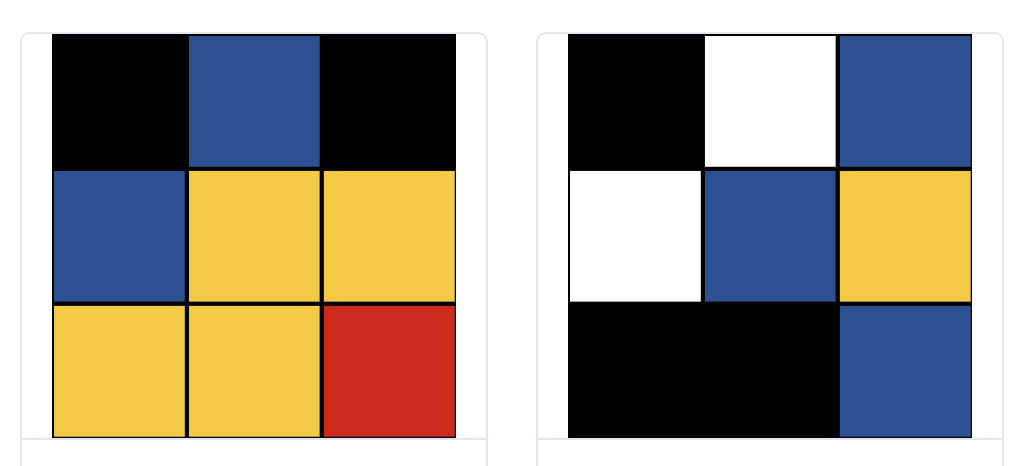Neolastics: Liquid, On-Chain, Generative Art
Neolastics is a new digital art project that I created that allows collectors to mint (and burn) new randomly generated pieces of neoplasticism inspired digital art. It’s liquid, meaning that at any point, a collector may choose to burn their piece to receive a reward from a communal reserve (a bonding curve).
This project is a continuation of experiments and ideation from 2016 around the creation of autonomous artists.
How It Works:
A collector can pay to mint a new randomly generated Neolastic piece from a smart contract.
The price to mint a new piece is determined by a linear bonding curve. In other words, a hardcoded price algorithm. If there are more Neolastics in circulation, the price to mint new Neolastics go up.
In turn, 99.5% of the funds paid to mint a Neolastic is kept in a communal reserve that acts as a buyer if any collector wishes to sell. The smart contract buys the piece and then burns it, forever removing it from circulation. If there are more Neolastics in circulation, then a collector will receive a high reward for burning their piece.
Each Neolastic piece contains 9 tiles that are comprised of 6 colors: white, black, red, blue, yellow, and green. All colours except green have a rough estimate of 20% to appear in each tile, while green is rarer: ~1/256 chance.
Why?
I’ve been fascinated with the idea of summoning and birthing an autonomous artist. This is a stepping stone project that also attempts to showcase the value of using a bonding curve economy for generative art collectibles.
To give some background: I’ve written on the creation of autonomous artists, birthed from a conversation over beers in 2016 with Trent McGonaghy and Greg McMullen. A brief timeline is below.
November 2016. A Software Agent Without Human Control that Produces, Owns & Sells its Own Art.
In this article, I sketched the first ideas. Some of these ideas would also be the start/form of what eventually would become bonding curves.
October 2017. Let’s Summon An Autonomous Artist - A Bot That Creates, Owns and Sells Its Own Art.
This was a more fleshed out proposal that used bonding curves. I called it ‘Artonomous’. In 2018, this idea was developed into a POC by a new team and won ETHBerlin hackathon.
Artonomous also led to early design explorations that would become Conviction Voting.
June 2019. Maximising Blockchain Collectible Economies
In this article I pointed out the ability to directly tie a bonding curve to an NFT economy such that it grows and shrinks based on demand. It partly solves the problem of: “How large should the collection be?” The answer: let the market decide.
August 2019. Clovers & Continuous Economies Around Algorithms
Clovers is a spiritual sister project that combines an automated economy around generative art. Well worth checking out. By Billy Rennekamp.
December 2019. New Markets In The Arts #2: Generative Art Economies
A solid encapsulation on early exploration in this space. Ultimately leading to ‘Abraham.ai’: a project led by Gene Koogan.
June 2020. https://github.com/artonomous/curved-generative-mvp/issues/1
Driven by a need to still see some of these ideas come to fruition, I penned down a simple MVP that eventually became Neolastics.
As you can see. It revolves around the combination of a bunch of ideas:
Generative Art.
On-chain Blockchain Art.
Automated through a bonding curve economy.
As the templates from Abraham.ai point out. If we combine this with a DAO that can change the generators software + some semblance of multi-party computation, we can come close to a real, autonomous artist that task a set of stakeholders to continuously improve itself: all automated.
Thus, for now, we start simple. And that’s what Neolastics hopes to prove as a baseline. A generative art collection backed by a bonding curve.
Why Neoplasticism?
I’ve always been a huge fan of Mondrian’s De Stijl artworks. Simple lines and colours. In a recent personal quest to recapture the grand narratives from modernism in my debut novel, it struck me that Mondrian pursued this too. With no sense of irony, he believed “the new 'pure plastic art' was necessary in order to create 'universal beauty'.” Design historian Stephen Bailey said of Mondrian: “'Mondrian has come to mean Modernism. His name and his work sum up the High Modernist ideal. I don't like the word ‘iconic’, so let's say that he's become totemic – a totem for everything Modernism set out to be.”
Because metamodernism is a dialogue that seeks to recapture part of the grand narratives of modernism, I wanted to bring neoplasticism into the 21st century. I think blockchain art captures that spirit well, because the market of art is so close to the actual artworks. So, it creates a sense of self-awareness while still pursing new, meaningful, beautiful art.
What next?
There’s been a slew of recent generative art projects that arrived in Ethereum. Project like https://artblocks.io/, https://www.squiggly.wtf/ or https://avastars.io/. I hope that this project can show that generative art can truly stand on its own with a new kind of economy using bonding curves, and then secondly continue on the path to creating autonomous artists. If there’s more demand for a collection, let the market mint more of it.
I’m looking forward to see what kind of economy develops around these pieces. Part of my belief is, is that this automated economy will indirectly curate the best and most wanted neolastics, due to the fact that it can readily be sold (and burned) if desired.
The code is available on github: https://github.com/simondlr/neolastics.
If you want to support me: 0.5% of each mint goes to me, to continue development on these ideas! Notably, after having invented bonding curves, this is the first project that I’ve built that uses it (yay)! 🎉
Enjoy!

